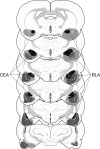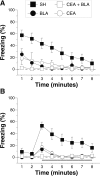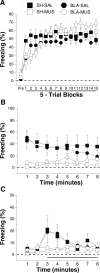The central nucleus of the amygdala is essential for acquiring and expressing conditional fear after overtraining
- PMID: 17848503
- PMCID: PMC1994080
- DOI: 10.1101/lm.607207
The central nucleus of the amygdala is essential for acquiring and expressing conditional fear after overtraining
Abstract
The basolateral complex of the amygdala (BLA) is critical for the acquisition and expression of Pavlovian fear conditioning in rats. Nonetheless, rats with neurotoxic BLA lesions can acquire conditional fear after overtraining (75 trials). The capacity of rats with BLA lesions to acquire fear memory may be mediated by the central nucleus of the amygdala (CEA). To examine this issue, we examined the influence of neurotoxic CEA lesions or reversible inactivation of the CEA on the acquisition and expression of conditional freezing after overtraining in rats. Rats with pretraining CEA lesions (whether alone or in combination with BLA lesions) did not acquire conditional freezing to either the conditioning context or an auditory conditional stimulus after extensive overtraining. Similarly, post-training lesions of the CEA or BLA prevented the expression of overtrained fear. Lastly, muscimol infusions into the CEA prevented both the acquisition and the expression of overtrained fear, demonstrating that the effects of CEA lesions are not likely due to the destruction of en passant axons. These results suggest that the CEA is essential for conditional freezing after Pavlovian fear conditioning. Moreover, overtraining may engage a compensatory fear conditioning circuit involving the CEA in animals with damage to the BLA.
Figures










Similar articles
-
Neurotoxic basolateral amygdala lesions impair learning and memory but not the performance of conditional fear in rats.J Neurosci. 1999 Oct 1;19(19):8696-703. doi: 10.1523/JNEUROSCI.19-19-08696.1999. J Neurosci. 1999. PMID: 10493770 Free PMC article.
-
Is there savings for pavlovian fear conditioning after neurotoxic basolateral amygdala lesions in rats?Neurobiol Learn Mem. 2001 Nov;76(3):268-83. doi: 10.1006/nlme.2001.4042. Neurobiol Learn Mem. 2001. PMID: 11726237
-
Associative structure of fear memory after basolateral amygdala lesions in rats.Behav Neurosci. 2008 Dec;122(6):1284-94. doi: 10.1037/a0012903. Behav Neurosci. 2008. PMID: 19045948 Free PMC article.
-
The amygdala, synaptic plasticity, and fear memory.Ann N Y Acad Sci. 2003 Apr;985:106-13. doi: 10.1111/j.1749-6632.2003.tb07075.x. Ann N Y Acad Sci. 2003. PMID: 12724152 Review.
-
The amygdala, fear, and memory.Ann N Y Acad Sci. 2003 Apr;985:125-34. doi: 10.1111/j.1749-6632.2003.tb07077.x. Ann N Y Acad Sci. 2003. PMID: 12724154 Review.
Cited by
-
Central amygdala glucocorticoid receptor action promotes fear-associated CRH activation and conditioning.Proc Natl Acad Sci U S A. 2008 Aug 19;105(33):12004-9. doi: 10.1073/pnas.0803216105. Epub 2008 Aug 11. Proc Natl Acad Sci U S A. 2008. PMID: 18695245 Free PMC article.
-
The Physiology of Fear: Reconceptualizing the Role of the Central Amygdala in Fear Learning.Physiology (Bethesda). 2015 Sep;30(5):389-401. doi: 10.1152/physiol.00058.2014. Physiology (Bethesda). 2015. PMID: 26328883 Free PMC article. Review.
-
Fear extinction in rodents.Curr Protoc Neurosci. 2009 Apr;Chapter 8:Unit8.23. doi: 10.1002/0471142301.ns0823s47. Curr Protoc Neurosci. 2009. PMID: 19340814 Free PMC article.
-
Bilateral phosphorylation of ERK in the lateral and centrolateral amygdala during unilateral storage of fear memories.Neuroscience. 2009 Dec 15;164(3):908-17. doi: 10.1016/j.neuroscience.2009.08.071. Epub 2009 Sep 6. Neuroscience. 2009. PMID: 19735699 Free PMC article.
-
Neural and cellular mechanisms of fear and extinction memory formation.Neurosci Biobehav Rev. 2012 Aug;36(7):1773-802. doi: 10.1016/j.neubiorev.2011.12.014. Epub 2012 Jan 2. Neurosci Biobehav Rev. 2012. PMID: 22230704 Free PMC article. Review.
References
-
- Balleine B.W., Killcross S. Parallel incentive processing: An integrated view of amygdala function. Trends Neurosci. 2006;29:272–279. - PubMed
-
- Bevins R.A., McPhee J.E., Rauhut A.S., Ayres J.J. Converging evidence for one-trial context fear conditioning with an immediate shock: Importance of shock potency. J. Exp. Psychol. Anim. Behav. Process. 1997;23:312–324. - PubMed
-
- Cahill L., Vazdarjanova A., Setlow B. The basolateral amygdala complex is involved with, but is not necessary for, rapid acquisition of Pavlovian 'fear conditioning.'. Eur. J. Neurosci. 2000;12:3044–3050. - PubMed
Publication types
MeSH terms
Substances
Grants and funding
LinkOut - more resources
Full Text Sources
Medical
Research Materials
